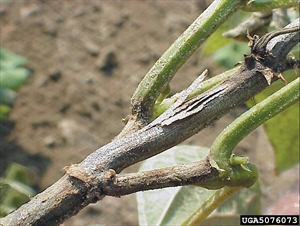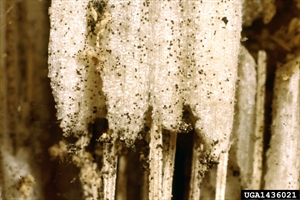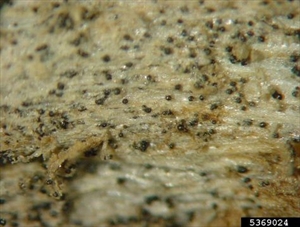Bean charcoal rot, ashy stem blight, damping-off, bean blight
Pacific Pests, Pathogens, Weeds & Pesticides - Online edition
Pacific Pests, Pathogens, Weeds & Pesticides
Bean charcoal rot (315)
Macrophomina phaseolina. Previously known as Macrophoma phaseoli, Macrophoma phaseolina, Macropshomina phaseoli, Rhizoctonia bataticola, Sclerotium bataticola.
Asia, Africa, North, South and Central America, Europe, Oceania. It is recorded from Australia, Fiji, New Caledonia, New Zealand, Papua New Guinea, and Solomon Islands.
Wide range of hosts in many families. In Pacific island countries, recorded from beans, capsicum, cocoa, and Caribbean pine. Cucurbits are also hosts.
The fungus usually attacks stems causing a watery rot at ground level. Rot may spread up the stem and into roots. On seedlings, the spots that develop are black sunken with sharp margins, which may girdle the stem. On older plants, the spots have ash-grey centres with dark margins (Photo 1). Symptoms on seedlings and older plants often occur more on one side of the plant than the other.
Infection of the root and stem prevents the flow of water and nutrients, and plants wilt. Leaves may fall, but infection of leaves is rare. When plants die, numerous small black dots form beneath the surface of the lower stem and tap root. The dots are 'sclerotia', balls of the fungus surrounded by a black protective skin (Photo 1-3). They are so numerous that they give the plants a sooty or charcoal appearance.
Spread is mainly through movement of soil or plant debris containing sclerotia, and seed. Survival is also by sclerotia in plant debris or in soil which remain alive for up to 3 years, depending on soil conditions, less if it is wet. Hot (soil temperatures of about 27°C), and dry weather favours the disease.
Worldwide. large losses (about 5%) have been documented on soyabeans, in the USA. High losses have also been reported in chickpeas, peanut, sorghum, and sunflower. However, it appears to be a minor disease in Pacific island countries, possibly because the hot, dry conditions needed during the growing time are not common to the region.
Look for the ash-grey spots at soil level on seedlings or older plants; often, wilting, yellowing and death is more on one side of the plant. Look for the tiny sclerotia that are characteristic of this disease.
CULTURAL CONTROL
Before planting:
- Use only disease-free seed (see below).
- Follow good nursery practices (if you are raising your own seedlings):
- Clean seedling trays by dipping them in household bleach (1-part bleach to 9 parts water) for 15-20 minutes, rinse and dry.
- Raise nursery plants in soil-less potting mix, or pasteurised soil mixes.
- Cover the soil with clear polyethylene tarps to heat the soil. Soil solarisation (for 30 days) has been found to be as good as fungicide.
- Plant in land where there is good tillage (if mechanisation is used) and soil moisture. It is probable that the disease is favoured by poor growing conditions: (i) if too wet, plants plant on raised beds or ridges, and (ii) if too dry irrigate.
During growth:
- Ensure that the crops have adequate nutrition by the application of fertilizers or manures. Note, excessive amounts of nitrogen may increase the disease.
After harvest:
- Use a 2-3-year crop rotation between susceptible crops on the same land. The difficulty with this recommendation is that the fungus has a wide host range. However, maize and sorghum are less-susceptible to the fungus compared to e.g., beans and other food legumes. Root crops, too, would be suitable in a rotation, but not sweetpotato as it is a host.
- Collect and burn or bury trash.
CHEMICAL CONTROL
It is unlikely that fungicides will be economic against this soil borne fungus, except as a seed treatment. For seed, treats with thiram (in Australia thiram with thiabendazole) is registered for seed treatment for peas and beans.
____________________
When using a pesticide, always wear protective clothing and follow the instructions on the product label, such as dosage, timing of application, and pre-harvest interval. Recommendations will vary with the crop and system of cultivation. Expert advice on the most appropriate pesticides to use should always be sought from local agricultural authorities.
AUTHORS Grahame Jackson & Eric McKenzie
Information from Charcoal rot of bean/tobacco (Macrophomina phaseolina). Plantwise Knowledge Bank. (https://www.plantwise.org/knowledgebank/datasheet/32134); and Diseases of vegetable crops in Australia (2010). Editors, Denis Persley, et al. CSIRO Publishing; and from Macrophomina phaseolina (2021). Wikipedia. (https://en.wikipedia.org/wiki/Macrophomina_phaseolina). Photo 1 David B. Langston, University of Georgia, Bugwood.org. Photo 2 Clemson University, USDA Cooperative Extension Slide Series, Bugwood.org. Photo 3 Paul Bachi, University of Kentucky research and Education Center, Bugwood.org.
Produced with support from the Australian Centre for International Agricultural Research under project PC/2010/090: Strengthening integrated crop management research in the Pacific Islands in support of sustainable intensification of high-value crop production, implemented by the University of Queensland and the Secretariat of the Pacific Community.






